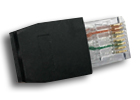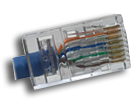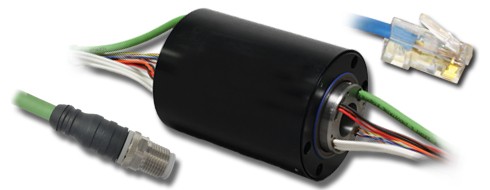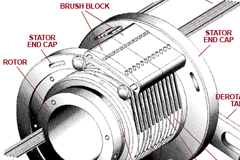Specifying an Ethernet Slip Ring
January 24, 2018
(updated October 2, 2020)
Ethernet has been operational in slip rings since the mid 1980s when it started being transmitted across twisted pair wire. As the format progressed the data speed increased requiring more bandwidth. Ensuring functionality through a slip ring has become dependent upon proper configuration. Passive slip rings can still handle the vast majority of Ethernet requirements today, but guaranteeing performance in your application requires we specify the following details up front to configure the optimal slip ring.
Questions to Ask Before You Begin
What Ethernet protocol am I running?
The protocol being used may provide several answers to the next few questions needed to properly specify the best slip ring performance.
Is it UDP or TCP?
TCP, or Transmission Control Protocol, is one of the main internet protocols and has error detection which will retransmit a packet of information if it is not received intact.
UDP, or User Datagram Protocol, also referred to as “real-time” Ethernet, has no error correction. It optimizes the speed of communication and is often used in industrial controls.
Moog recommends a more robust slip ring configuration for UDP Ethernet formats using fiber brushes and gold plated rings. Small capsule designs can transmit UDP signals error free for extended lengths of time and may be suitable for some UDP applications depending on rotational speed, environment, and needed life. However, in production environments where a couple of lost packets can result in a system shut down that may not be sufficient. Fiber brushes paired with gold plated rings offer error-free UDP signals for the life of the product and at extremes of the rated operational environment.
What is my data speed, 10/100_T vs. 1000_T?
Many commercial Ethernet cables come with four twisted pairs, but only two of those pairs are used for data when operating at 10 or 100_T.
1000_T, also known as Gigabit Ethernet or GigE, requires all four twisted pairs.
Due to the cost and space it takes for each Ethernet twisted pair, only those needed are populated in our slip rings. There are exceptions to this rule like Power over Ethernet or PoE. This protocol usually operates at 100_T, but the other 2 twisted pairs are still needed as they support power to a PoE device.
Do I need a shielded cable?
Shielded Ethernet cables are common, but the industrial standards (CAT 5/5e and CAT 6/6A) do not impose a requirement for a shield. Unless otherwise specified, most or our catalog Ethernet slip rings will be provided without a shield.
Shielding is used in high electromagnetic interference environments to reduce the corrupting effect of EMI on the cable’s data. If you know your environment has heavy EMI, then you may want to take the precaution of shielding your cable. If you do not know, then there is a trade-off to consider. Shielding can increase the size of the unit required and does have a cost impact. If the rest of your system is shielded, we would recommend maintaining the shield through the slip ring. We offer options for shielding on most Ethernet slip rings.
What about if I’m running power through the slip ring?
When we lay out the circuits within a slip ring, power and Ethernet are isolated from one another. No more protection is needed than if you had power and Ethernet cables running together outside of a slip ring. If you have a noisy power supply, you are likely taking steps to protect your Ethernet signal external to the slip ring. Similar steps would need to be taken inside it. If nothing is needed outside the slip ring, our standard isolation internal will be sufficient.
FAQs
Can power be sent through the same slip ring as the Ethernet signal?
Yes, much like Siemens cables which combine both signal and power, Moog slip rings can handle any level of current and voltage they are rated for without disruption to the Ethernet.
As mentioned in the Shielding section, there may need to be steps taken internal to the part if you have a noisy power supply, but otherwise, this is the normal expected usage.
Are there other connector options besides Male RJ 45?
Yes, we have chosen to configure all of our Ethernet parts with Male RJ 45 connectors so the slip ring can be seen as a standard patch cable. This is the most widely used termination of Ethernet cables, but is not always the best.
M12 connectors are more robust and easier to seal. We offer these in male and female D-coded options. Others can be considered upon request.
We do not offer Female RJ 45s and instead recommend using high quality female to female couplers with our Male RJ 45s.
Common Misconceptions
My system requires Cat 6 cable to operate at 1000_T.
Cat 5 will support 1000_T and has a bandwidth of 100 MHz. Cat 5e has improved crosstalk parameters, but supports the same bandwidth of 100 MHz.
Cat 6 further improved crosstalk with tighter twisting & thicker insulation. It also increased frequency response to 250 MHz to support 10G for up to 55 meters. Cat 6A has improved bandwidth to 500 MHz and supports 10G for up to 100 meters.
Moog slip rings are tested to the Cat 5e specification. We currently support up to 1000_T or GigE. Some of the smaller capsules have met Cat 6 cable requirements and could support higher than 1 Gbps, but reliably achieving 10G has not been proven.
One aspect of the cable that may need to be considered is the wire AWG. Many of our smaller capsules use 28 AWG twisted pair wire. Though the CAT parameters are met, the total usable length of cable could be impacted. If your system has a long total cable run length, it would be best to contact us to discuss your specific setup. We can match you with the ideal product to ensure performance. This could also come into play when using PoE to power a device that draws a higher wattage than is standard.
Cat 5e/6/6A requires a shield.
As mentioned earlier, the cable specifications do not require a shield. Cross-talk requirements are met using Unshielded Twisted Pairs. Any requirement for shielding would be based on system requirements instead of cable specifications, and should be communicated during the quoting stage.
Watch this video for key information on ethernet and high definition slip rings.
Contact Us
The questions and notes above provide a baseline for configuring the best slip ring for your specific application. These are just the basic questions we ask, and get asked on a regular basis. With the multitude of Ethernet, or Ethernet like, communication protocols there are often unique requirements and we can usually find a slip ring solution.
For more information on Moog Ethernet slip rings and how they can be configured for your application, contact our slip ring experts.

About the Author
Ben Rudisill is the Business Development Manager of Commercial Slip Rings at Moog, working at Moog’s Blacksburg, VA, operations. With 16 years of experience in the industry, Ben provides technical sales support to match slip ring solutions with customer’s application needs.





